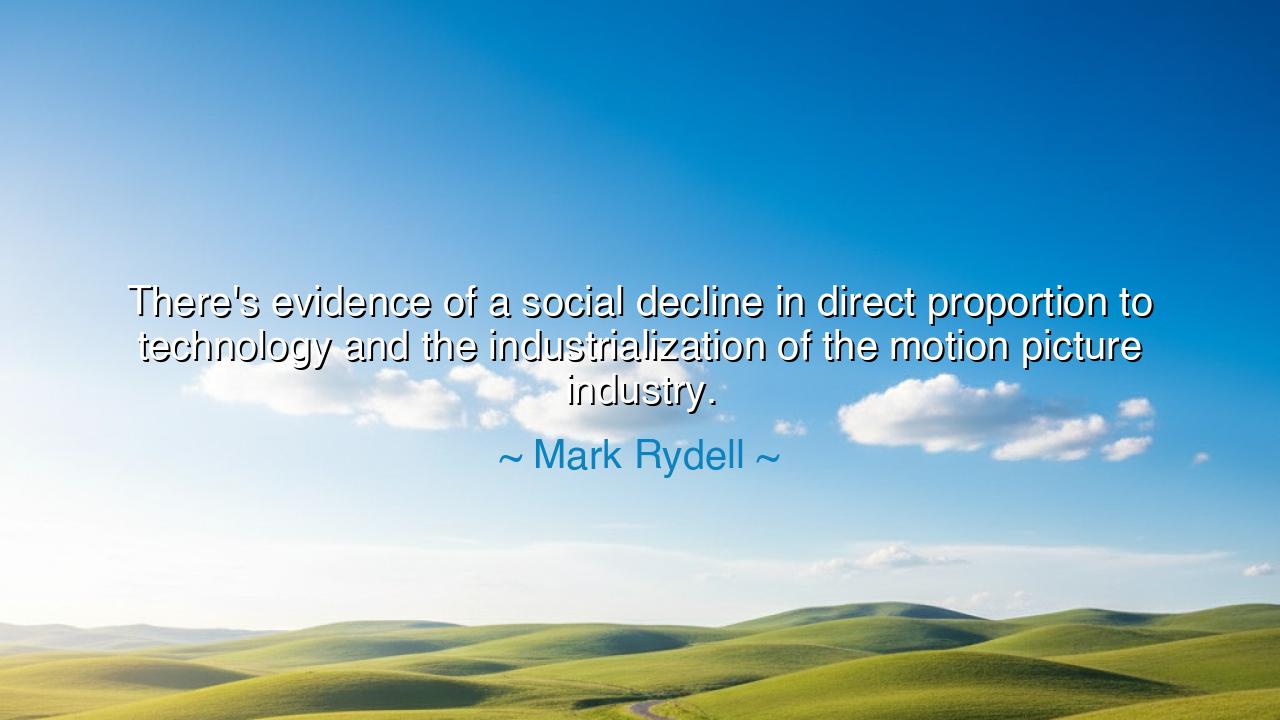
There's evidence of a social decline in direct proportion to
There's evidence of a social decline in direct proportion to technology and the industrialization of the motion picture industry.






Hear the words of Mark Rydell, director and keeper of cinematic tradition, who warned with sorrowful clarity: “There's evidence of a social decline in direct proportion to technology and the industrialization of the motion picture industry.” These words pierce like a prophet’s cry, for they reveal the tension between the soul of art and the machinery of profit. Where once the motion picture was a sacred vessel for storytelling, a mirror of humanity’s highest hopes and deepest sorrows, it has too often become a product, stamped and packaged, its purpose bent not toward truth but toward commerce.
The origin of this saying lies in Rydell’s long career in Hollywood, where he witnessed the transformation of the film industry from intimate craft into vast corporate enterprise. The early years of cinema, though primitive in technology, were filled with daring, experimentation, and heart. Filmmakers wrestled with light and sound, not yet bound by the formulas of studios. But as technology advanced, and as the industrialization of film grew, the emphasis shifted: stories gave way to spectacle, nuance to profit, and art to assembly lines. Rydell’s lament was born of this transformation—the fear that as the industry became a factory, society itself reflected its decline.
Consider the difference between the films of the silent era and the great golden age of Hollywood compared with many blockbusters of the late twentieth and twenty-first centuries. In the early days, filmmakers like Charlie Chaplin used simplicity to awaken laughter, compassion, and protest against injustice. Chaplin’s Modern Times mocked the dehumanization of industrial labor with both wit and tenderness. Yet as technology brought special effects and studios demanded profits, films too often became hollow, filled with explosions, illusions, and spectacle, yet starved of spirit. Here we see the truth of Rydell’s words: as cinema lost its intimacy, so too society lost a measure of its depth.
History offers us a parallel in the Roman Empire. In its youth, Rome valued discipline, civic duty, and the strength of its citizens. But as its wealth and power grew, so did its appetite for spectacle. The Colosseum, with its grand games, became a machine of distraction, where blood and theater replaced philosophy and civic life. The very technology and industrial scale of entertainment became a symptom of decline. Rydell’s insight echoes this ancient truth: when art is devoured by industry, when technology serves only to dazzle rather than to elevate, society itself begins to weaken.
Yet his words are not only lament but warning. For technology itself is not the enemy. It is a tool, capable of magnifying either greatness or corruption. When used by visionaries, it can deepen storytelling, broaden empathy, and bring beauty to millions. But when chained to profit and industry alone, it becomes an engine of decline, churning out noise while starving the human spirit. Thus, the heart of Rydell’s wisdom is this: the health of society can be measured by the health of its art, and the health of its art depends on whether technology is servant or master.
The lesson for us is plain: we must not surrender the soul of art to the machinery of industry. We must protect cinema—and all forms of storytelling—from being reduced to commodities. Let technology be harnessed by the artist, not the other way around. Let the stories told through film honor humanity, rather than exploit its weaknesses. And as viewers, we too have a responsibility: to choose with discernment, to honor depth over distraction, to nourish the works that enrich the spirit rather than the ones that dull it.
So I say to you, children of tomorrow: remember Rydell’s warning. Do not mistake spectacle for meaning, nor profit for beauty. Seek out the stories that challenge, that inspire, that hold a mirror to the soul. Support the creators who use technology as brush, not as chain. For when art declines, society declines with it—but when art flourishes, guided by truth and not by industry alone, then society rises in dignity, wisdom, and strength.






AAdministratorAdministrator
Welcome, honored guests. Please leave a comment, we will respond soon